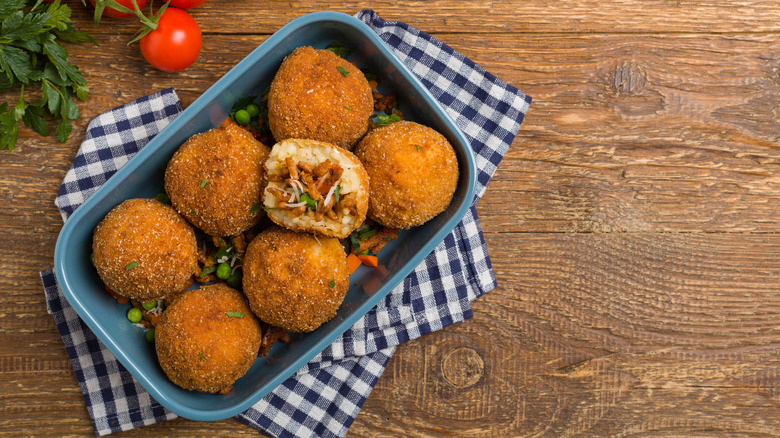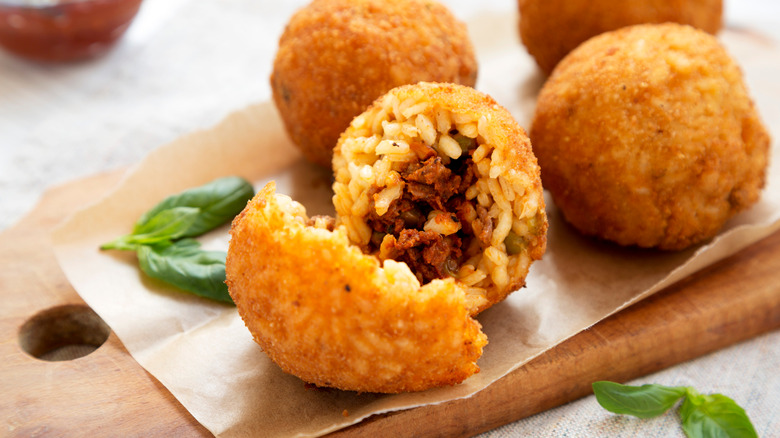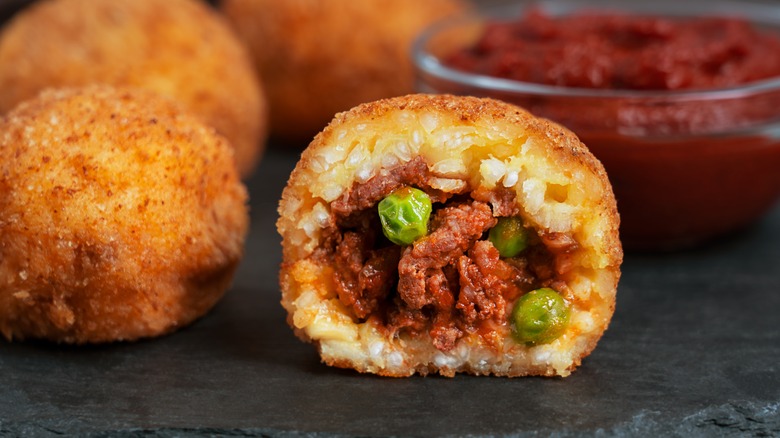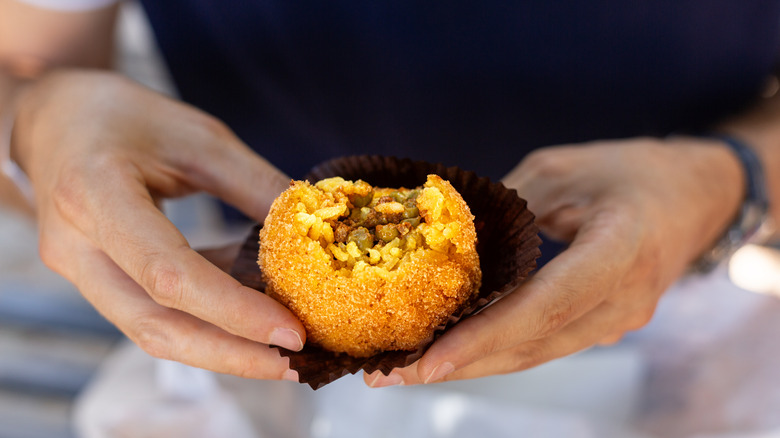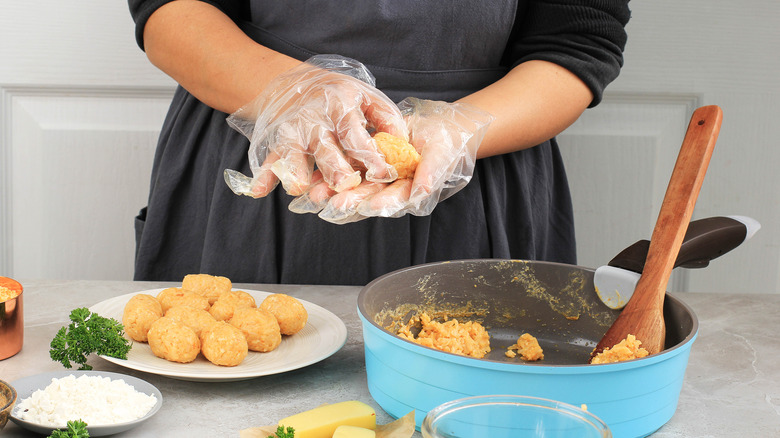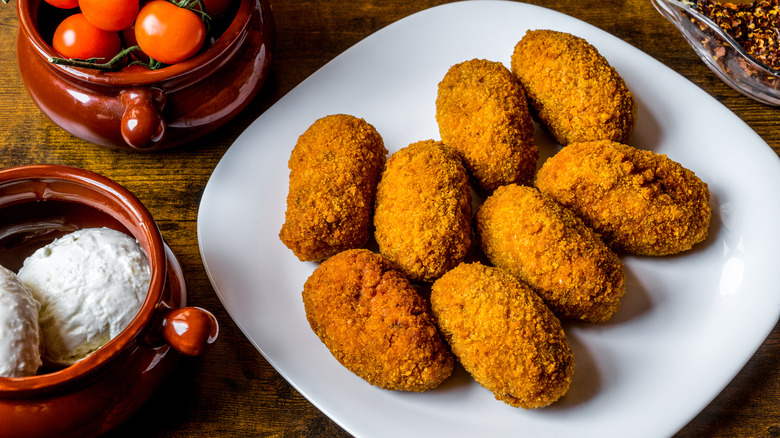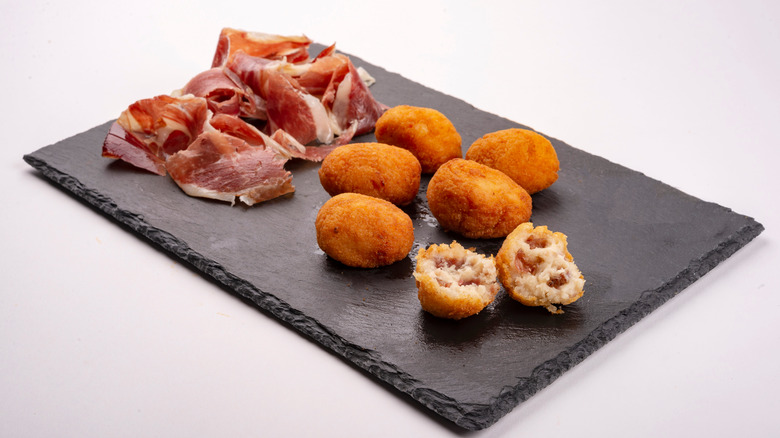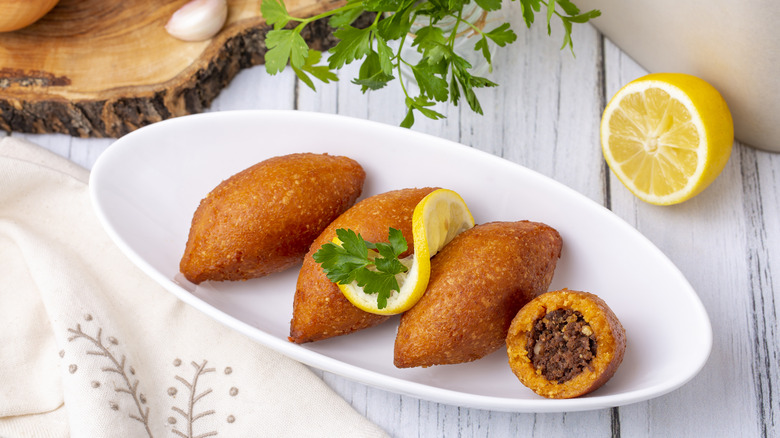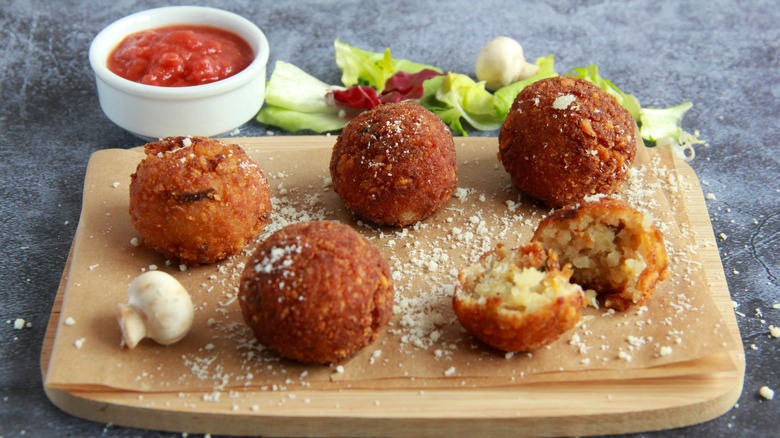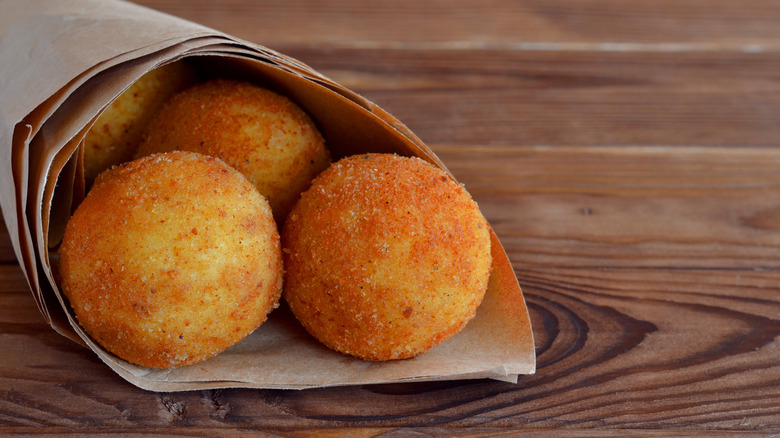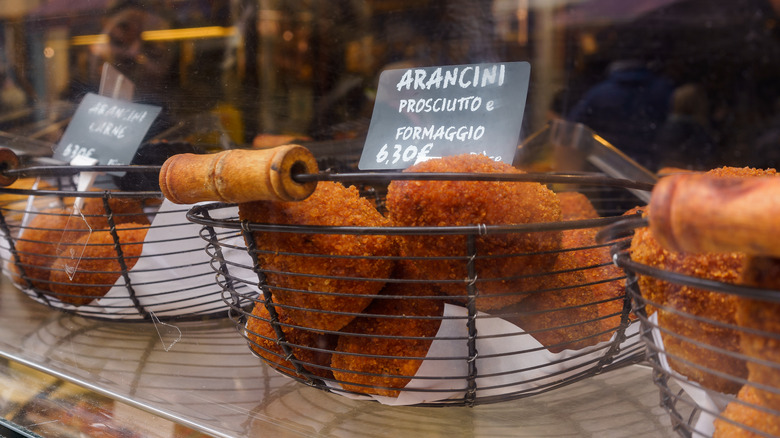What Is Arancini And How Is It Made?
When you think of Italian street food, things like pizza, focaccia, and cannoli probably come to mind. But in Sicily, the island at the toe of the Italian boot, street food means arancini. Arancini translates to "little oranges" in Italian, and indeed, these fried balls look like little oranges. But when you open them up, they're far from a sweet, citrusy treat. Arancini are fried balls of rice stuffed with a filling. They are golden orange in color due to saffron rice and the deep frying process.
Arancini is the product of two food cultures coming together to create something new. Food historians can trace the dish back to the 10th century, when Sicily was under Arab rule. The precursor to arancini was a rice dish flavored with saffron and bits of lamb. This dish became a portable snack when the Emperor Frederick II wanted to enjoy his rice on a hunting trip. Later, when tomatoes made their way over from South America, they were incorporated into arancini, transforming the dish even further.
These days, arancini is sold all over the island — and indeed, all over the world. Hungry for more info on this irresistible food? Then stick around: We're breaking down everything you need to know about arancini.
What is arancini?
Arancini is one of the most popular foods in Sicily. They're found in food stalls, restaurants, and trattorias all over the island. Originally, arancini were made with saffron-flavored rice, and the filling was a typical Italian ragu made with tomatoes, minced meat, carrots, and peas. But these days, the filling can be anything from seafood to mushrooms. There's even such a thing as sweet arancini, stuffed with chocolatey goodness. The shape also ranges from round to conical, depending on where in Sicily you are.
For a long time, arancini was not common outside of Sicily. But then Sicilian author Andrea Camilleri wrote a series of detective novels about a larger-than-life character named Inspector Salvo Montalbano who adores arancini. The humble arancini is mentioned throughout the character's series, along with many other Sicilian foods. This put the island's cuisine in the spotlight. Later, when the series was made into a television film, the public's love for the quirky protagonist grew even more intense. This made everyone want to eat like the Inspector. Thus, arancini's legend spread.
How is arancini made?
The base of arancini is rice, but not any rice will do. It needs to be a starchy rice, preferably of a short grain variety. The best rice for arancini is arborio rice because it can hold its shape and stand up to being breaded and fried. In Sicily, this rice is added to water or stock with saffron, and is boiled without stirring. This sets the arancini-making process apart from that of its similarly rice-centric cousin, risotto. Risotto requires continual stirring of the rice, to help it break down and get a velvety texture. But with arancini, the rice keeps its shape and texture.
Once the rice is cooked, it's left to cool, then shaped into balls. The filling is added at this point. Arancini are generally the size of small oranges, but can be as big as softballs. The smaller ones are sold as snacks, while the larger ones are more commonly found in sit-down restaurants where the arancini is the main course. Notably, arancini deviates from the traditional flour, egg, and breadcrumb routine that characterizes so many fried foods. They're covered in a thick paste made of water, egg, and flour. This batter is called pastella, and it has two functions: It holds the ball together and it gives the breadcrumbs something to stick to so they don't fly off during the frying part. After the arancini is rolled in breadcrumbs, it's deep-fried in oil.
What does arancini taste like?
Arancini has a crispy outside and a textured inside. The rice is chewy, but the center varies wildly, depending on filling. Some forms of arancini boast gooey melted cheese mixed in with a ragu, somewhat like a fried mozzarella stick with a crunchy outside and a molten center. Arancini is typically made with caciocavallo cheese, but any cheese that melts well, such as mozzarella, provolone, or Asiago, can work. Other arancini stick to meat and veggies. Peas are a popular choice.
Traditionally, arancini rice is flavored with saffron, giving it a sweet, earthy flavor. When arancini is made from leftover risotto, though, the rice keeps its original flavor, which usually doesn't contain saffron. This opens up a lot of flavorful possibilities, though. For example, arancini made from leftover mushroom risotto will have bold umami flavor that deliciously complements a soft center of melted cheese.
Surprisingly, despite being deep-fried, arancini aren't greasy. The breadcrumb coating has a lot to do with this; deep-frying it makes it incredibly crispy, rather than oily, thanks to its absorbency. In some regions, people also add a little Parmigiano Reggiano to the breadcrumbs for a slight nutty flavor.
How to make arancini at home
Homemade arancini is a fun project that's easier than it sounds. First, start with rice. There are many different kinds of rice and methods of cooking it, so be sure to select arborio rice and cook it according to the package. Don't forget to season it, either. You can go the traditional route with saffron, but saffron can be expensive, so if you're on a budget, you can use other herbs that match your choice of filling. When the rice is cooked, spread it out on an oven sheet to cool. While it is cooling, make your filling. You can also skip this entire part and simply use leftover risotto. If using risotto, add an egg to the rice as a binder.
Next, use your wet hands to shape the rice into balls. You can also use a meatball shaper, or two spoons. Make a space in the ball to add the filling, and add more rice to cover it. Once the arancini are formed, place them in the refrigerator for 30 minutes to help them keep their shape. Then, you can do as the Sicilians do and cover them with the pastella, or just do a simple breading of flour, egg, and breadcrumbs for a lighter taste.
Luckily, you don't need a deep fryer to make arancini at home — you can simply use a deep pot, like a Dutch oven. Use a neutral oil and add enough to keep the balls covered while frying. Serve hot with a side of marinara dipping sauce.
Arancini vs. Roman suppli
There are many regional variations of classic Italian foods out there. Take Roman suppli, a dish that resembles arancini. Suppli are similar to arancini in that they're made with arborio rice, breaded, and fried. But instead of a round or conical shape, suppli are oblong and resemble fried mozzarella sticks. Suppli are traditionally only filled with mozzarella and served with a marinara sauce, unlike arancini, which has more variations and heartier fillings including meat, cheese, and vegetables. Roman suppli are popular in pizzerias and casual dining spots as an antipasto or appetizer.
Originally, suppli was a street food. There are two theories of how it got its name. The first is that during the time of Napoleon, when the French occupied Rome, French soldiers bit into the foreign-looking suppli and were surprised by its hot melted cheese. Surprise, or "surprendre" in French, stuck as a name. The second theory is that the name comes from the stretchy cheese itself. When pulled apart, it kind of looks like a telephone wire, or "supplì al telefono."
Arancini vs. Spanish croquettes
Arancini and Spanish croquettes look similar, but they're actually quite different. The principal difference is that croquettes are small fried tapas (light bites typically served at bars) made with potatoes instead of rice. They can be sold as street food like arancini, but are usually served in a restaurant. While tasty on their own, they're downright exceptional when eaten alongside a crisp drink.
With their oblong shape and fried shell, Spanish croquettes look similar to arancini, as well as fried jalapeno poppers and mozzarella sticks. But with one bite, you'll understand exactly how different they are from the Italian snack. The inside of croquettes is a soft mixture of mashed potatoes and bechamel sauce, as well as other elements, like ham. This makes them something of a sophisticated cousin to the humble tater tot, as well as arancini. And, as with arancini, there is no one way to make Spanish croquettes.
Arancini vs. Middle Eastern kibbeh
Sicily was part of the Arab world back in the 10th century. As cultures overlap, so does food. Consider arancini and kibbeh, which share many things in common. Kibbeh is a classic Middle Eastern dish. It's made throughout the region with slight variations, just like arancini. Traditionally, though, kibbeh is made with cracked bulgur wheat, minced meat, and spices. It is formed into little balls and fried and can be made with beef, lamb, or ground chickpeas, for a vegetarian version. Typically, kibbeh is served as part of a mezze plate with hummus, baba ghanoush, falafel, and pita bread.
Throughout the Middle East, you can find different forms of kibbeh. In Lebanon, it is the national dish, and served with yogurt sauce. In Israel, kibbeh is made with the addition of either pine nuts or pomegranate seeds, giving it a nice crunch. In Syria, there are a whopping 17 versions of kibbeh. However, the one that most closely resembles arancini is Iraq's version of kibbeh, which is made with long-grain white rice instead of bulgur wheat.
Varieties of arancini
Classic arancini is made with saffron-seasoned rice, Italian ragu meat sauce, and cheese, but that's just the start. Arancini varies throughout Italy, and as it becomes more popular, new versions are created using conventional and unconventional ingredients. There are many different types of arancini, from sweet to savory to meat-filled to vegetarian, and more are being invented every day.
Throughout Sicily, you'll find arancini made with ham and mozzarella or spinach and mozzarella. In Catania, arancini is made with eggplant and pistachios. Puglia has a similar approach: This city's arancini is filled with mortadella and pistachios. In other parts of Italy, you can even find arancini filled with spaghetti instead of rice. Italian celebrity chef Giada De Laurentiis stuffs her arancini with porcini mushrooms and peas.
Savory arancini gets most of the attention, but sweet versions are just as good. Sweet arancini can be made with rice pudding instead of rice, and filled with anything from Nutella to dried fruits to caramel. Pumpkin and cocoa nib arancini are a particularly elegant variation. Essentially, there are no rules when it comes to this foodstuff. If you're making your own, try getting creative with asparagus and prosciutto arancini, Pate de Campagne arancini, or strawberry and chocolate arancini. The possibilities are endless.
Nutritional information for arancini
Arancini's nutritional information depends on how they're made and how big they are. The great thing is, if you're making them at home, you can make them exactly how you like. If you want a lighter take, a vegetable filling helps, as does making them smaller. Or, if you want truly hearty arancini that can act as a meal, go big and add a savory protein and fatty cheese. If you're specifically interested in arancini's fat content, you should know that you can lower it significantly by making them in an air fryer rather than deep-frying them in oil.
What nutritional basics can we establish? Let's start with the rice. One quarter cup of uncooked arborio rice is 170 calories. The majority of those calories come from carbs. So, if you're on the keto diet or living a low-carb lifestyle, arancini is probably not for you. Then there's the filling. This is best understood through an example — in this case, Canadian pizza chain Pizzaville's classic ragu-filled arancini. They have 90 calories per ball. Compare this to Whole Foods' frozen arancini stuffed with mozzarella, which have 100 calories per ball. These are fairly good examples of the typical arancini's nutritional breakdown, but take note — they're not necessarily representative of all arancini.
Where to buy arancini
Arancini still isn't as popular in the U.S. as other Italian foods like pizza, calzones, and focaccia. But you can find them in many Italian restaurants, international supermarkets, and Italian specialty shops. Some specialty shops and farmers' market vendors specializing in Italian foods may even sell fresh arancini. If they're not on the menu in your favorite local spot, you can always ask the chef if they ever put them on the special menu. If there's enough customer interest, many restaurants can be convinced to try something new. Some Italian food-focused caterers may also make them in large batches to sell.
Frozen arancini are easier to find; they're available online and in many supermarkets' frozen foods sections. However, frozen arancini vary wildly in taste and texture. Trader Joe's arancini bites are much smaller than typical arancini, for example. These smaller versions often lack filling other than cheese, and are mostly breading. Some people like that, but others don't. Try out multiple brands to figure out your favorite.
